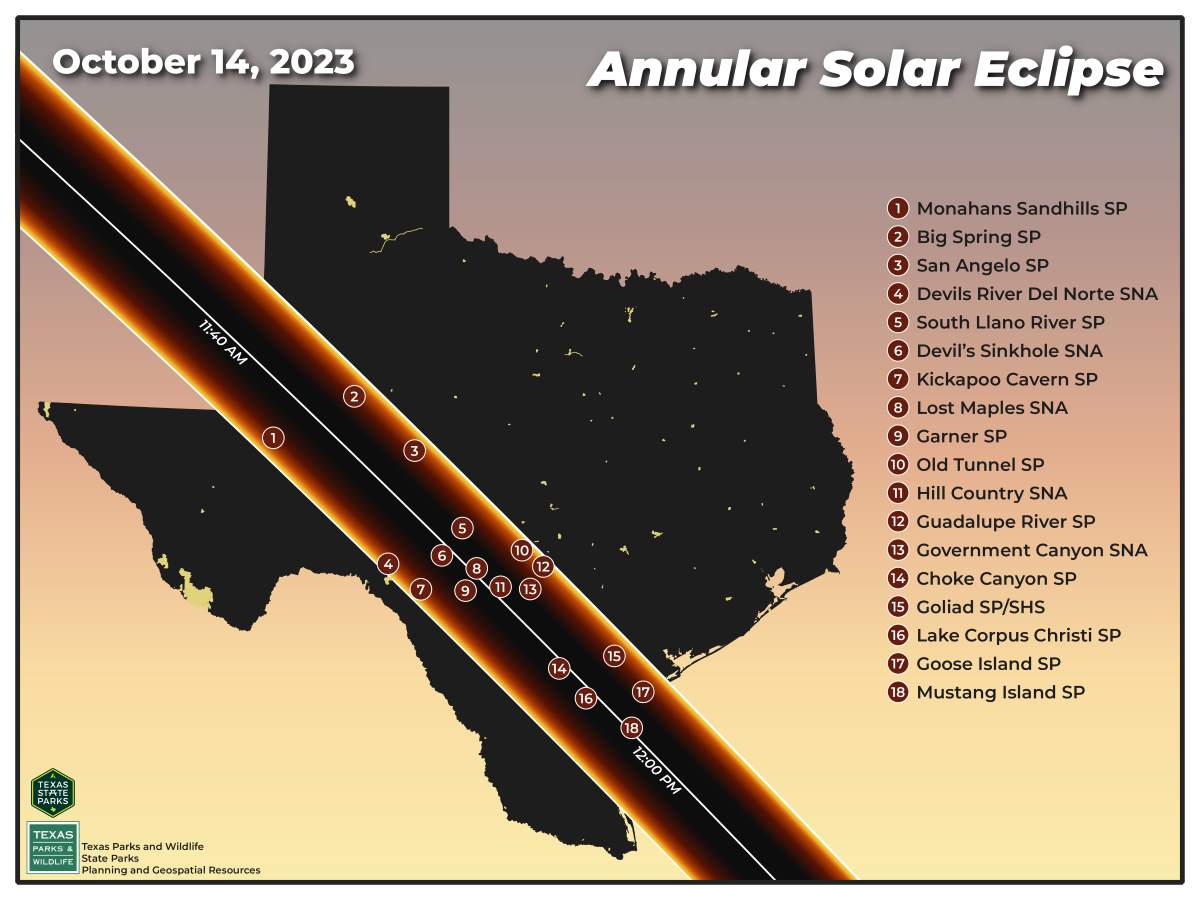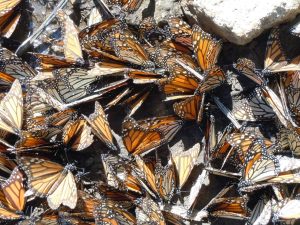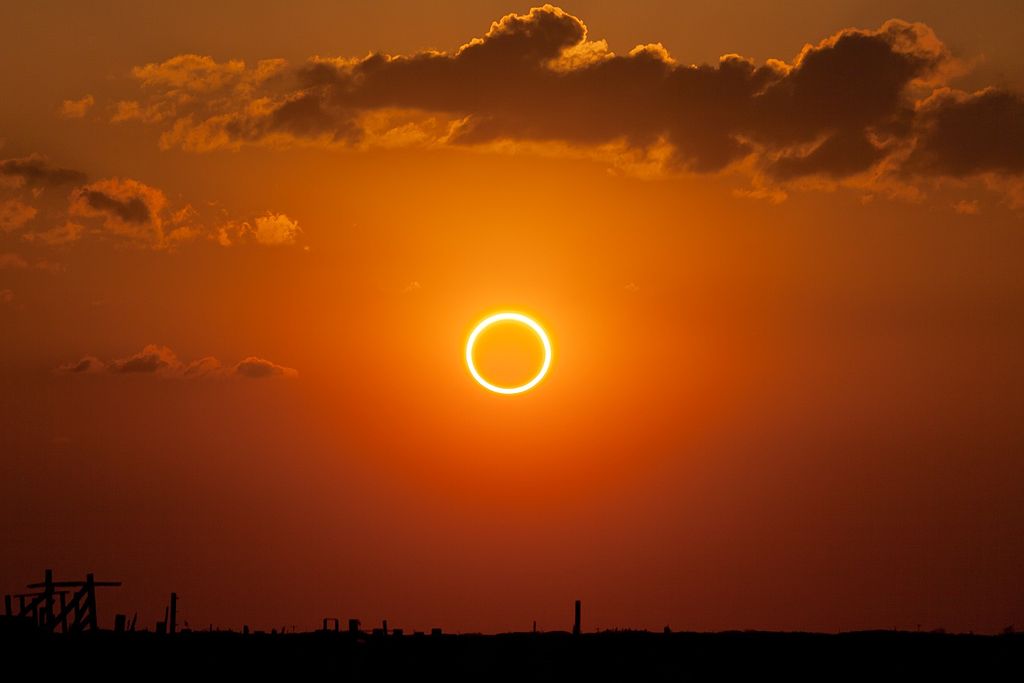Nature lovers will have a double dose of unique events to enjoy in the Texas Hill Country this October. Monarch butterflies will be moving through what’s known as the Texas Funnel on their way to their overwintering sites in Mexico just as the annular solar eclipse unfolds on October 14.
Monarchs make this trek every fall with peak migration typically occurring October 10 – 22.
The next ‘ring of fire’ annular solar eclipse won’t happen in this stretch of Texas for another 217 years, according to Space.com, a website devoted to astronomy and space news. But a full solar eclipse will occur in this same neighborhood on April 8, 2024–around the same time monarchs will be heading back north from Mexico to launch a new generation of butterflies.

Peak monarch migration and peak annular solar eclipse paths overlap on October 14th in Texas this year. –Graphic via Texas Parks & Wildlife
In the Texas Hill Country, the annular eclipse will last from around 10 AM to about 1:30 PM, depending on one’s exact location. Will the midday darkness affect the migrating butterflies?
Scientists think not, although several said that no one has actually studied this particular question.
David James, who researches California monarchs at the Washington State University, said the partial solar eclipse is “unlikely to affect migrating monarchs, beyond maybe causing them to temporarily roost.” He said it would certainly not affect the direction or sustainability of their migration.
Longtime monarch butterfly researcher Karen Oberhauser agreed. She said the eclipse won’t have an impact.
“We had a full eclipse in the Midwest a few years ago, and it didn’t seem to impact them. I don’t think they last long enough to mess up their perception of day length or any other environmental cues,” Oberhauser shared via email.
Migration studies expert Andy Davis said he doesn’t expect anything extraordinary to happen. “Most animals likely won’t notice,” he said.
André Green, a scientist at the University of Michigan who’s been working on tracking monarchs with radio tags and will be in the Texas Hill Country for the confluence of events, said it will be an interesting spectacle to witness. “I imagine they might try to find a place to roost as if it were night during the eclipse…I’m guessing they will just hunker down in place,” he said.


While observing monarch butterflies requires no special gear, those witnessing an eclipse should wear special eclipse glasses to protect their eyes from sunburn. Looking directly at the ultraviolet light of an eclipse can damage and permanently harm the retina.
Some entrepreneurial folks have set out to tap the overlapping occurrence of these unique natural phenomena.
In Oakville, Ontario, the Monarch Butterfly Eclipse Project, an initiative started by five high school students, launched an awareness campaign marrying monarch butterfly conservation and eclipse appreciation by creating and selling monarch butterfly-themed solar eclipse glasses. The organization’s website points out that the total solar eclipse in April closely mirrors the migration route of the monarch, as it will start in Mexico and move north, not far from the monarchs’ northward spring migration route.
The project’s cardboard-rimmed glasses are ISO Certified and imprinted with monarch butterfly and eclipse graphics–dark black background with orange, gold and white flourishes. Profits from sales of the glasses go to The Monarch Butterfly Eclipse Foundation.
TOP PHOTO: Annular solar “ring of fire” eclipse. Kevin Baird, CC BY-SA 3.0 via Wikimedia Commons
Related posts:
- IUCN revises listing of monarch butterfly from “endangered” to “vulnerable”
- Monarch migration underway as new studies suggest butterflies are “not in danger”
- Q & A : Migration studies expert Andy Davis says, for monarchs, it’s survival of the biggest
- Recent IUCN “endangered” listing creates confusion for monarch butterfly followers
- Eastern monarch population up 35% this year, but still much work to do
- Dejavu: is 2022’s dry spring setting the stage for another Texas drought like 2011?
- Three monarch butterflies tagged in honor of those who died recovered in Mexico
- They’re here! Drought conditions greet monarch butterflies as they arrive in Texas
- Massive arrivals of monarch butterflies in the Texas Hill Country signal 2021 migration is on
- Courtship flights, late departures define recent visit to Piedra HErrada sanctuary
- Late, robust monarch butterfly migration evokes cautious optimism
Like what you’re reading? Don’t miss a single post from the Texas Butterfly Ranch. Sign up for email delivery, like us on Facebook, or follow us on Twitter, @monikam or Instagram.


Yesterday in the San Francisco area, I watched as a traveling Monarch pilgrim stopped and sipped nectar from flowers on our grounds. It was wonderful to observe life finding it’s way!
I also saw the a Monarch traveling south this morning in Easton, PA ; in the evening around 5:45pm I saw a Ruby Throat Hummingbird at my pink petunias. They are amazing little wonders.
Just a note. I’m in Rule, TX and up to today, Oct 6th, we’ve seen Monarchs in ones and twos a day. Late this morning I noted around a dozen. By a little after noon my count had increased to at least 50+ just during a short walk through the garden. Looks like the leading edge of the fall migration now. I am now waiting to see what happens after this next cold front expected overnight.
All of the butterflies appear to be in good shape and flying well and strong. I’ve reported my sighting on Journey North.